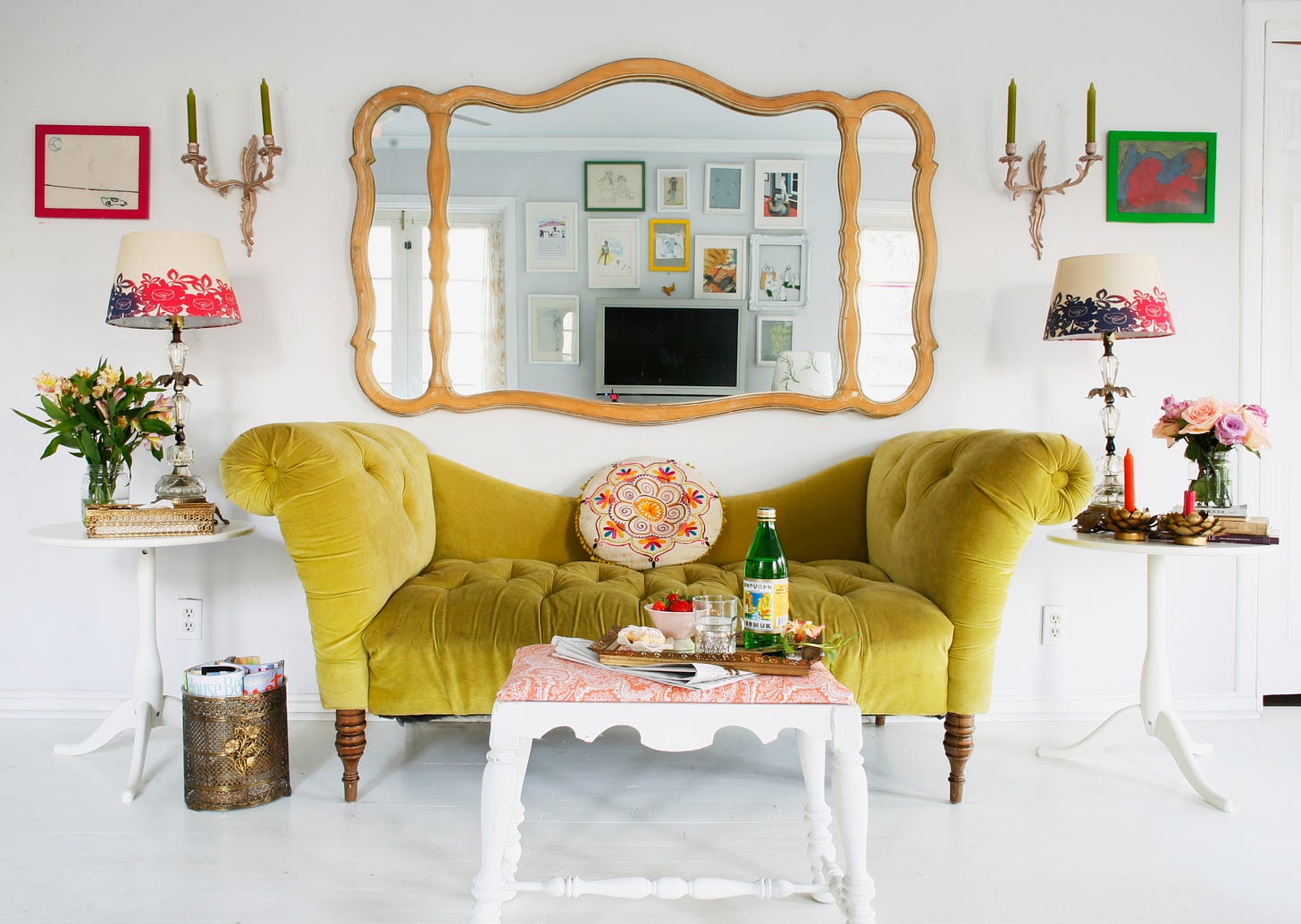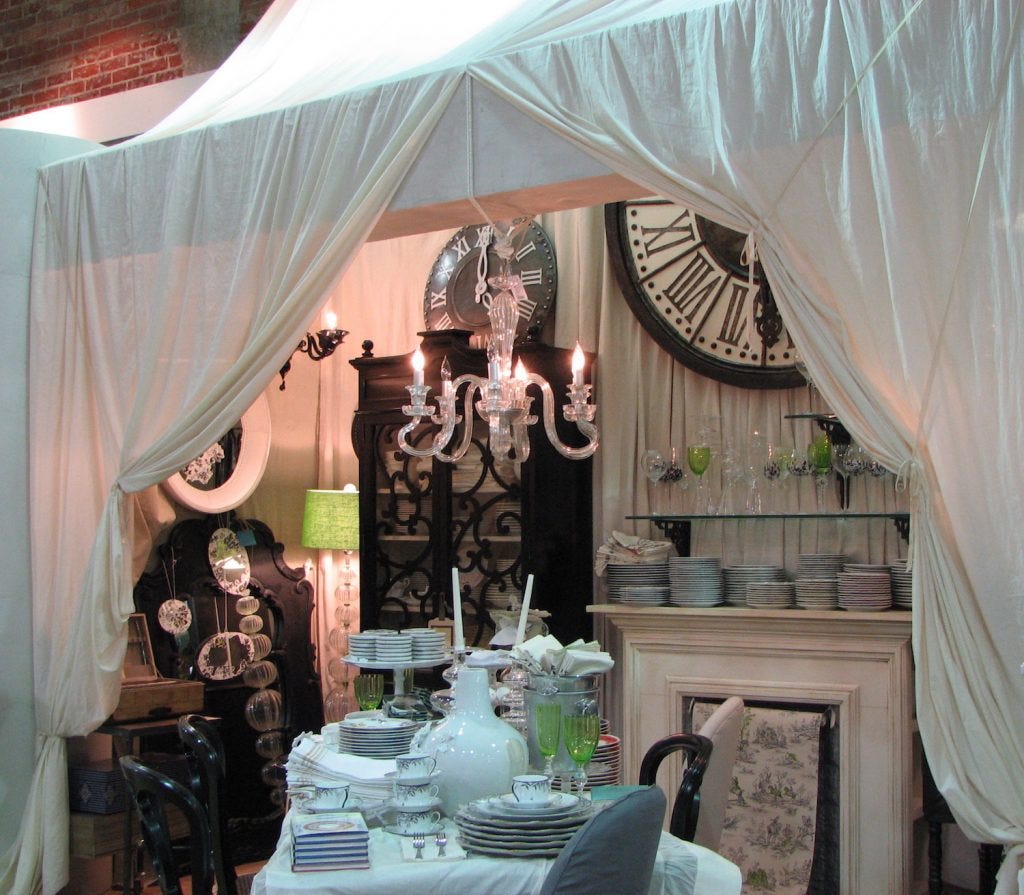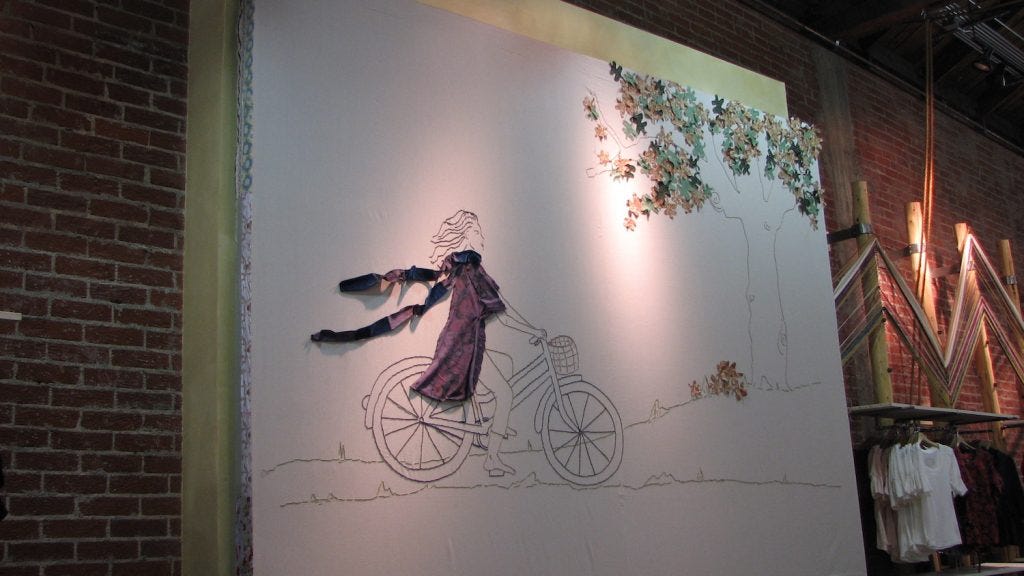Due to the popularity of my last post on how I style my home like a visual merchandiser I thought I’d re-publish a two part post I wrote on my old blog about becoming a stylist. I’ve never understood why people think it’s rude to ask people what they do for work when you meet them. I love hearing about people’s jobs no matter what they do. I like to hear about the minutiae of their day and how they came to be in that line of work. I get asked a lot about how I became a stylist which is why I wrote these two pieces back in 2019. I do feel like a part three is due - styling in a post pandemic London/world. We’ll see.
But for now, here is Part One: Los Angeles. (Click the title above to read this free post on the app and leave me a comment).
Not a week goes by without me receiving emails from aspiring stylists asking for advice. I’ve always done my best to reply to each one because I remember writing the same emails to stylists when I was starting out and they very rarely replied. But after years of writing the same message and occasionally not having time to reply at all, I thought I’d share some insight here as well. Every stylist will have a different story about how they made interior styling their career. There isn’t one fail-safe route and everyone’s circumstances will be different, so the only story I can offer is my own in the hope that you might glean some valuable information if you’re hoping to follow a similar path.
There are now college courses available in interior styling, and this is certainly an option if you feel like you need to get some basic understanding of the theory behind styling. I actually taught a four day workshop in Taiwan about what a stylist does (I was told it’s a relatively new career path there) and it was fun to share the nuts and bolts of shoots and the relationship between stylist and photographer and stylist and client. A quick google search in your area would bring up some course options, I’m sure. However, sometimes the best way in is to assist an experienced stylist – or many – and learn from them. If you have a passion for interiors and photography and you’re willing to start from the bottom and work hard, on the job experience is – in my opinion – the way to go. That’s not exactly what I did at the very beginning (I’ll explain), but it’s still what I advise.
Lesson One: Be proactive
You have to get out there and start meeting people. Reach out to stylists whose work you admire and offer yourself as an assistant, explaining a little (but not too much – very long emails can be off-putting) about why you want to be a stylist, your experience – if any – and what you think you have to offer. You could consider offering to assist for free, but only at the very beginning of your career, with the express intent to gain some more experience and see how things work on set. I never advise working for free past this beginning stage – you should be valued and paid for your time in all but the rarest of occasions. Email stylists and then email again a couple of months later, so that your name sticks. Don’t be a pest, but there’s nothing wrong with a follow up email, an “I’m here if you need me!” reminder. Many of the assistants I’ve used in recent years have been the ones who emailed a few times and whose names got into my head.
My story is a little different as I started my career a bit later and because I was a bit older I was reluctant to assist someone else, potentially for a few years as is the norm. I had children straight after university so I hadn’t had the chance for a proper career. (Ever the entrepreneur though, for the first five years of my first born’s life I designed a line of kid’s clothing and sold it in high end boutiques, but that’s another story). When my children were little and I was living in Los Angeles, I closed the kid’s clothing business and got my first ‘proper’ job working in an Anthropologie store as their display artist, and later visual merchandiser. Part of the interview process was to make something that you thought represented Anthropologie. Leaning on the sewing skills I’d learned from making samples for my kids’ clothing line, I made a decorative cushion with patchwork fabric and hand embroidered detail – and I got the job. As the display artist I learned so much about different crafts and art techniques and I also gained more experience with power tools and machinery. After a year or so of display – hand-making elaborate window and in-store displays in the art room at the back of the store – I became the apparel merchandiser. Essentially I was placing the clothes in the store, but in an artful and considered way, cross merchandising with homeware product and display, and creating a cohesive and compelling story, based on the company’s guidelines but with my own flair. I had a great manager who taught me a lot about the fine art of merchandising and display and I turned out to really have a knack for it.
When I was working on displays, I’d frequently be up a 10′ ladder, balancing with a drill or a glue gun in my hand, and customers would ask if I ever helped people decorate their homes. I’ve been interested in interiors from a very young age, constantly styling my rooms as a child and teenager and I really have no idea why I didn’t study interiors at university. Put it down to being too passive about decision-making at the time, not really focusing on the future, being a teen too interested in boys and clubbing. I don’t know. It’s a shame that I wasn’t more forward thinking.
So when those customers asked me if I wanted to help decorate their homes, the old idea ignited again and I realised that yes, I could probably do that. I ended up leaving Anthropologie after a couple of years and went on to decorate a few rooms in the home of a lovely lady who I’d met through my job. I also re-designed a sanctuary/chill out room in a local hair salon, again with connections made at my former job. I had no formal training and I did most of the manual labour myself, but both clients were happy. I struggled with how to charge interior design clients and definitely under-paid myself massively, but I learned a lot and moving forward always tried to value what I did. You live, you learn.
Lesson Two: Photograph everything. Even your early work that will later make you cringe!
In 2005 I’d bought my first home in LA and had been ripping it apart and decorating it for few years, experimenting as I went. My ex-husband and I did most of the work ourselves as we had a young family and not much money, so it was a proper creative DIY time in my life. He was very good at building things, not because he was trained, but because he was one of those people who are annoyingly good at most things they try. Very helpful in this scenario. I ripped up old tile, he laid new. He sanded wooden floors, I painted them.
It’s at this same time that blogs like Design*Sponge and Apartment Therapy were starting to get quite big and I thought it would be amazing if my home could be featured on one of them. Already I was thinking about the power of publicity. I didn’t think I was good enough to take the photos myself – I already understood enough about the difference between a snapshot and a professional picture and I knew I wanted the latter – so I started to look for a photographer. I really couldn’t afford to spend money on one, but I’d been working an evening job when my kids were in bed, styling clothes for a fashion website (literally styling outfits on a mannequin from different angles in a little photographic studio. The kind of shots you see when online shopping. Thrilling stuff.)
The photographer was quite young and new to the business like me. He said he’d like to try interiors photography and he agreed to shoot my house for free, happy to be adding a new section to his portfolio. Those images, shot on a cloudy day in LA, ended up being one of the most popular home tours Design*Sponge had done at that time – my green velvet sofa in an all white room was (and still is) much loved!
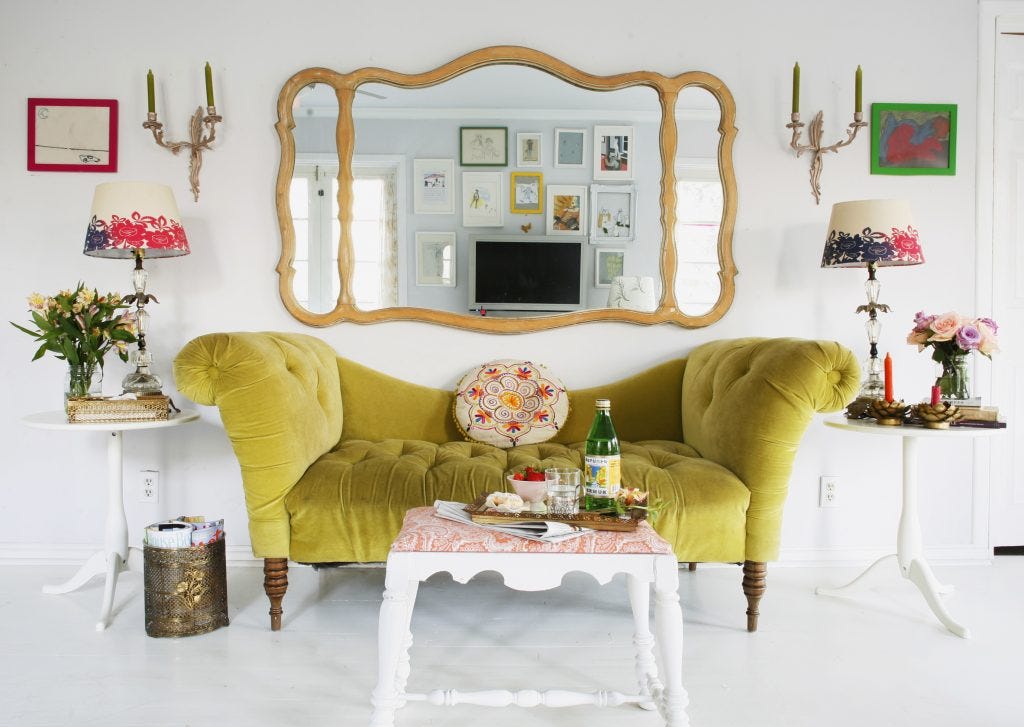
I was being asked more and more to help people with little home projects – friends and family mostly – and I saw this as an opportunity to gain more experience and also to build a portfolio, even though I wasn’t making money. My sister-in-law had bought this very unusual house in LA – an old water tower that was completely cylindrical and I helped her with a bit of decoration. Not full scale, just styling and tweaking. And again I thought I should photograph it. By chance I saw an ad in a local paper for a photographer called Teri Lyn Fisher. On a whim I called her up, again not really having the cash to spend, but just seeing where it would lead. Teri was a relatively new photographer working mostly in food, and trying to build her own portfolio while she still occassionaly assisted another photographer. She too was interested in doing more interiors so she agreed to shoot some of my projects.
Lesson Three: Find a friend to team up with
Partnering up with a photographer who is at the same level as you is really important. You can work together on ‘test shoots’ where you design your own concept for a shoot and create it together, as you would for a client. This gives you experience working with photographers and it also gives you imagery to begin to build a portfolio. If you’re interested in prop styling for food shoots, create a mini cookbook shoot; if you want to work with soft furnishings, style a cushion and textiles shoot; or if you are interested in prop styling and set design for fashion shoots, find a fashion student who might like to work with you on a personal project. It may take a small investment of your own funds to make the shoot happen, but split with the photographer, it’s a small price to pay. Do you have friends who have interesting homes or gardens – can you trade with them for the use of their space for your shoot? Or maybe you know someone with a studio – again, what can you offer in exchange for half a day of its use?
Teri was the one who suggested I try styling and she introduced me to a food photographer she worked with called Matt Armendariz. Matt and his partner Adam Pearson were this amazing photography/styling duo, working from their studio in Long Beach, California. Matt shot the pictures and Adam styled the food and often did the props, using beautiful pieces from their massive props room. Knowing I had zero experience prop styling for food shoots, they still asked me to work on some projects with them. I have no idea why as I literally didn’t know what I was doing – but I’m eternally grateful to them!
Lesson Four: Say yes and figure it out later! Don’t let fear of failure get in the way. (Unless you think you’ll really, really mess things up then maybe wait a bit…)
The first thing I styled with them was a cookbook – I can’t remember the concept, but I remember the sheer joy I felt ‘shopping’ in their props room and coming up with different sets of plates and linen and glassware for each shot. (Fifteen years on, I still feel this way when I go to a props house and I’ve even built up my own props business in recent years, hiring out items from my collection to clients for shoots I’m styling). My visual merchandising days at Anthropologie had come in handy – knowing how to group product by colour and texture to create a compelling story for the customer wasn’t far off from what I did with each cookbook shot, albeit in a different context. I went on to shoot numerous cookbooks with Matt and Adam as well as advertising shoots for Chiquita bananas, alcohol brands and lots of others I can’t even remember.
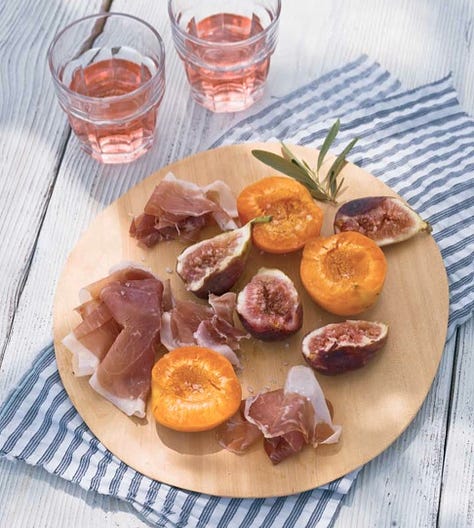
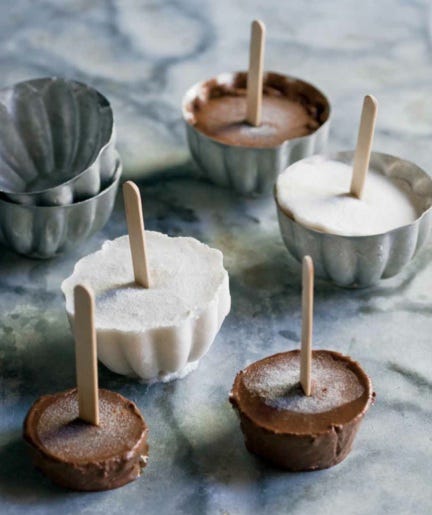
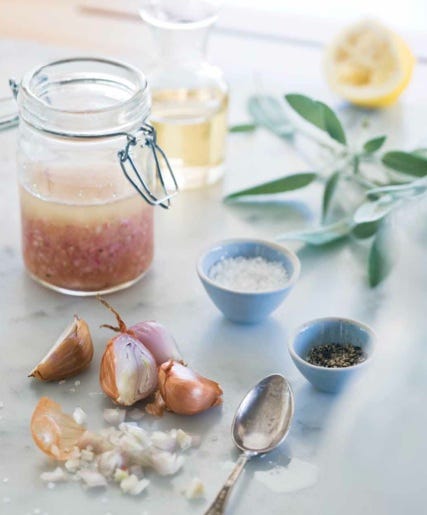
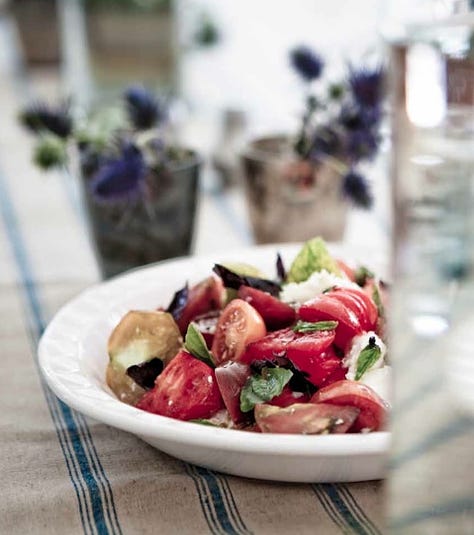
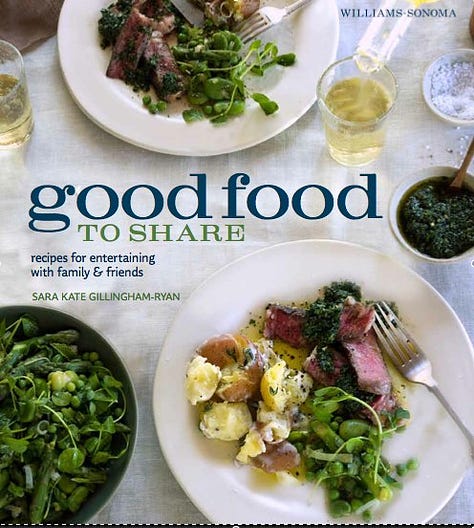
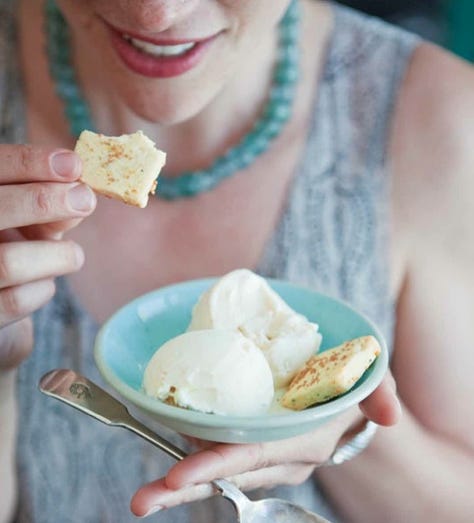
After this I also started working with another food photographer Ray Katchatorian – I’m not sure how I met him but it was probably a referral from these early styling jobs. I worked on a couple more beautiful cookbooks, one in an incredible home literally under the Hollywood sign, and I felt so lucky to be working with these industry veterans. I paid attention to the way things worked on set, to the expectations of the client, to the way the photographer liked to work and I just kept my head down and got on with it, certain that at any moment they’d all figure out I had no idea what I was doing! Ah the heady days of major imposter syndrome. Thankfully those days have passed for me, with a decade and a half of experience under my belt.
I also started to get asked to style for some regional magazines: Rue, Anthology, California Home + Design, also through referrals. This is the thing: often once you get your foot in the door and you’re good at what you do and you’re nice to work with, the work finds you. So I would style homes of people who were being featured in magazines. I styled Joy Cho’s (Oh Joy blog) apartment and the homes of celebrity hairdressers and the heads of design agencies. These jobs are always a bit odd to me because there often isn’t much to do. You bring flowers and maybe food props but often the homes are so beautiful and ready that you’re just plumping cushions or moving furniture to camera a bit.
Lesson Five: Make yourself indispensable
I had also started to be asked to assist very established stylists on really big shoots. At this point I was probably in my early thirties – maybe 32 – and assisting didn’t sound great. But I decided to swallow my pride since they were such big clients and I understood that I could learn a lot and I could make new contacts. I assisted on Target shoots in crazy Malibu houses overlooking the Pacific Ocean, I assisted out of town stylists who needed help sourcing vintage props locally for shoots, and I tried to make myself indispensable. You want me to quickly drive down the hill to the gourmet supermarket to find ten watermelons for the next shot – sure! You like my trainers and you want to borrow them as a prop in the poolside shot – no problem! I said yes to everything. And people love that. I’m not saying to be an endless people pleaser, but you have to pay your dues and being the go to person on set who gets shit done is often remembered by clients and photographers. Next time they need someone, they may think of you.
Lesson Six: know your place on set
This may sound harsh but it’s important. It’s better to be remembered for being a quiet hard worker who gets stuff done, as above, than the chatty one who sat around checking her phone or talking to the photographer too much. I’m sometimes shocked at the audacity of certain assistants – both the stylist’s and photographer’s – who have no sense of place. I worked on a shoot recently where the photographer’s assistant was at various times singing at the top of his lungs, calling his phone service provider and loudly arguing through the phone, and generally acting really arrogant. In my opinion the photographer should’ve dealt with him and made him realise it wasn’t appropriate behaviour. You may be able to get away with this once you’re established (although do you want to be that person?), but it’s not great when you’re starting out. You’ll get noticed for all the wrong reasons! (I later found out said assistant was dating said photographer, so I guess the boundaries were a little blurry…)
Anyway, back to LA. I started to get asked to style some shoots for those bigger clients – perhaps shoots that were a bit beneath the established, creative stylists, but manageable for an up and coming assistant. So maybe the more experienced stylist would be doing the main campaign shoot at the beautiful mansion and I’d be styling the same garden furniture but for the basic product shots in a studio. But I didn’t care. The money was good and I got to work on my own with the photographer’s team and get more and more experience.
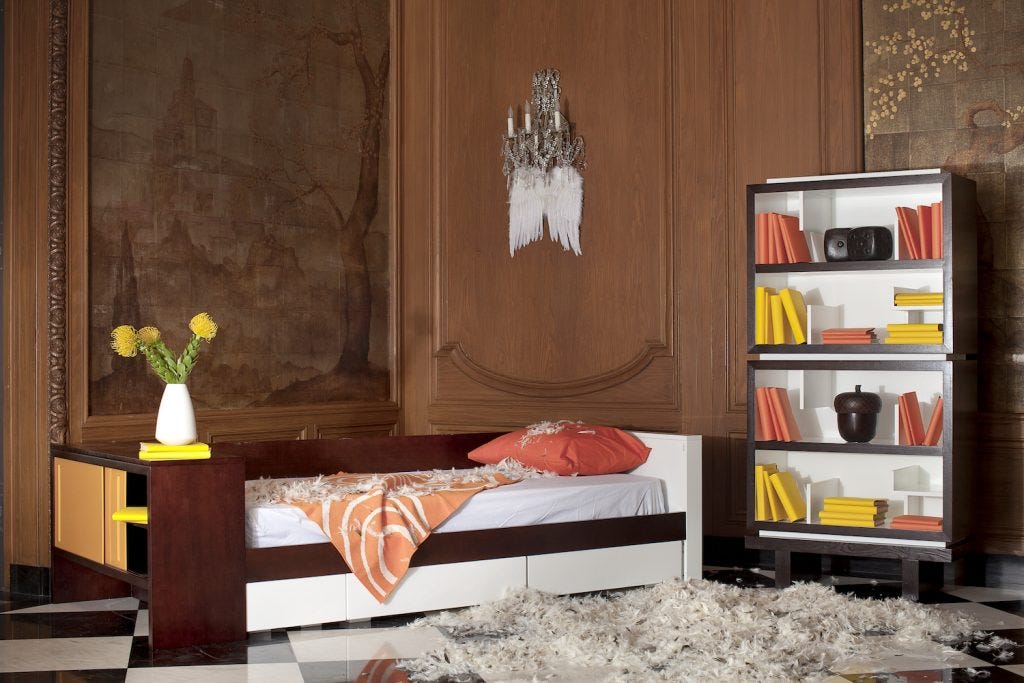
One day, out of the blue I got a call from a production company in New York about a series of commercials they were shooting in Toronto. They’d seen images from my portfolio – the ones I did of my house with the amateur photographer – and they were interested in me doing the production design on their TV commercials based solely on those photos. I’d never done anything this big, but they seemed to think I was the right person for the job, so I did what I always do and I said yes and figured it out! I spent a week in Toronto working with a huge crew, heading up the production design of the commercials. I was the head of the whole art department and in way over my head, if I’m honest. I mean, waaaaaay over. It’s the kind of job you’d typically build up to, learning the ins and outs of the system of being on these types of sets. TV is very different from stills photography - the teams, the hierarchy, the way of doing things. I knew none of this.
But I was very lucky to work with an amazing local team who helped make it all happen – without their local knowledge I would’ve been in trouble. It was an incredibly challenging job and I did a lot of secret crying in bathrooms while I wondered what the hell I’d got myself into. But I’m glad I grabbed the opportunity because the end result was great and I learned so much and I didn’t screw it up! Refer back to lesson four
Lesson Seven: Don’t be afraid to shake things up
I continued like this for a few years, styling here and there and gaining more and more experience, but I still wasn’t getting the work I really wanted and I felt a bit stuck. I needed to shake things up a bit. The interiors style in LA is very different – it’s often more polished and perfect, and you know how I feel about that! I was still buying expensive export copies of Living Etc and Elle Decoration, craving that European quirkiness that was often missing from American publications. I was also flicking through interiors books by British stylists and wondering if I’d ever have the career I wanted in the US. I thought if I had an agent that would help, but no-one would represent me, probably because I still didn’t have enough experience or maybe my style wasn’t commercial enough. Creatively I wasn’t feeling challenged and I was having a hard time getting to that next level.
It’s at this time that my then husband and I started to discuss the idea of moving back to London. He’s from LA and our kids were both born in the States, but I’m a Londoner through and through, and after 18 years of living in the US I thought I was ready to come home. I also wanted my kids to experience living in the UK and at age eight and 12, it wasn’t going to get any easier for them if we waited. This would be a risky move, but everyone was on board. Both of us would essentially have to start over again with our careers, making new contacts in our respective industries; we’d need a new home, schools, jobs, furniture – it could all go horribly wrong…
Next time, in Part Two: London I’ll share how big risks often lead to bigger rewards. Moving countries AGAIN was the hardest but most rewarding thing I could’ve done. Starting over AGAIN at the ripe old age of 35 eventually paid off, but not without countless setbacks and failures along the way. I’ll also share some of the nuts and bolts of what is expected of you as both an assistant and a stylist.



